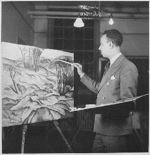Hale Woodruff
| Hale Aspacio Woodruff | |
|---|---|
 Hale Woodruff in studio | |
| Education | Herron School of Art, Chicago Institute of Art |
| Known for | Murals |
| Notable work | Amistad Mutiny murals (1938-1942) |
| Spouse(s) | Theresa Ada Baker |
Hale Aspacio Woodruff (August 26, 1900 - September 6, 1980) was an African-American artist known for his murals, paintings, and prints.
Early life, family and education
Born in Cairo, Illinois in 1900, Hale Aspacio Woodruff grew up in Nashville, Tennessee, where he attended local segregated schools. He studied at the Herron School of Art and Design in Indianapolis and at the Chicago Institute of Art.
Woodruff won an award from the Harmon Foundation in 1926,[1] which enabled him to spend four "crucial years studying in Paris from 1927-31."[2] He enrolled at the Academie Scandinave and the Academie Moderne. He learned in the city's museums as well, while getting to know other expatriates including Henry Ossawa Tanner, the leading African-American artist. He met leading figures of the French avant-garde and began collecting African art, which was a source of inspiration for many other modernists, including Pablo Picasso.[3] He returned to the U.S. and married Theresa Ada Baker in 1931. They had one son, Roy.[4]
Art career
Returning to the U.S. in 1931, Woodruff established an art school at Atlanta University. This meant teaching classes at the university's Laboratory High School as well as for students at Morehouse and Spelman, a school for women. Then Woodruff went to Mexico in 1936 to study as an apprentice under the famed muralist Diego Rivera, learning his fresco technique and becoming interested in portrayal of figures.[2] He returned to Atlanta and continued teaching. He began traveling to Talladega College in Alabama to teach and work on a commission for a series of murals .
Woodruff applied his understanding of Post-Impressionism and Cubism to painting for social advocacy after his return to the United States in 1936, during the Great Depression.
Woodruff's best-known work is the three-panel Amistad Mutiny murals (1938) that he did for the Savery Library at Talladega College. The murals are entitled: The Revolt, The Court Scene, and Back to Africa, portraying events related to the 19th-century slave revolt on the Amistad. They depict events on the ship, the U.S. Supreme Court trial, and the Mende people's repatriation to Africa. (The murals were recently restored in a collaboration between the High Museum in Atlanta and the college. They are now on a national tour, and will be in Kansas City in the summer of 2015.)
The library has an image of the ship that is embedded in its lobby floor. College tradition prohibits walking "on" the ship, despite its central location. In addition, the library has another series of three Woodruff murals exploring events from the historically black college's college's role in African-American history, including freedmen enrolling after the American Civil War and the construction of campus buildings.
His two other surviving murals are "The Negro in California History" for the Golden State Mutual Life Insurance Company in Los Angeles, done in 1949 as a collaboration with Charles Alston, and six panels completed around 1951 called "Art of the Negro" at the Clark Atlanta University Art Galleries.[5]
In 1942, even with World War II raging, Woodruff was able to initiate the Atlanta University Art Annuals that lasted until 1970, making 29 national art exhibitions for black artists.[6]
Then in 1946, Woodruff joined the faculty at New York University, where he taught for more than 20 years before retiring in 1968. Malkia Roberts was among his New York pupils.[7]
References
- ↑ African-American Artists, 1929-1945: Prints, Drawings, and Paintings in The Metropolitan Museum of Art
- 1 2 Roberta Smith, "In Electric Moments, History Transfigured - Hale Woodruff’s Talladega Murals, in ‘Rising Up,’ at N.Y.U.", New York Times, 13 August 2013
- ↑ http://www.high.org/Art/Exhibitions/Rising-Up-Hale-Woodruff.aspx
- ↑ "Five Decades of Greatness in Art, Hale Woodruff". African American Registry. Retrieved 2016-01-16.
- ↑ http://www.georgiaencyclopedia.org/articles/arts-culture/hale-woodruff-1900-1980
- ↑ Dunkley, Tina. "Hale Woodruff (1900-1980)." New Georgia Encyclopedia. 06 December 2013. Web. 28 May 2015.
- ↑ "Swann Galleries - The Richard A. Long Collection of African-American Art - Sale 2359, Part I - October 9, 2014". Retrieved 3 February 2017.
Further reading
- David C Driskell; Leonard Simon; Los Angeles County Museum of Art, Two centuries of Black American Art, (Los Angeles County Museum of Art; New York: Knopf : distributed by Random House, 1976) ISBN 0-87587-070-8, ISBN 978-0-87587-070-0
- Hale Woodruff 50 Years of His Art, (New York : The Studio Museum in Harlem, 1979) OCLC: 17813325
- Samella Lewis, African American Art and Artists, (Berkeley: University of California Press, 1990) ISBN 0-520-08788-7, ISBN 978-0-520-08788-0, ISBN 978-0-520-08532-9
- Kenkeleba Gallery (New York, N.Y.), The Search for Freedom: African American Abstract Painting 1945-1975, (New York:Kenkeleba House, ©1991) OCLC: 30743648
- Marika Herskovic, American Abstract Expressionism of the 1950s: An Illustrated Survey, (New York School Press, 2003.) ISBN 0-9677994-1-4. pp. 358–361
- Crystal Britton, African American Art: The Long Struggle, (New Line Books, 1998)
- Samella Lewis, African American Art and Artists, (University of California Press, 1994)
- Sharon Patton, African-American Art, (Oxford University Press, 1998)
- Romare Bearden, A History of African-American Artists: From 1792 to the Present, (Pantheon, 1993)
External links
- "Amistad Murals", Talladega College